|
abot90-7
|
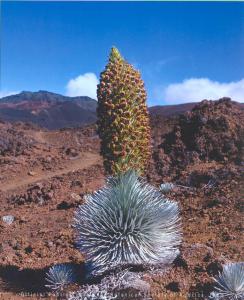
|
Agroxiphium sandwicense subsp. macrocephalum, photographed on the Silversword Loop Trail in Haleakala National Park, Maui, Hawaii. The silverswords in Haleakala National Park grow in the largest number on these cinder cones in the caldera of Haleakala, but since goats have been removed from the National Park, silverswords are colonizing other areas of alpine lava. Photo credit: Sherwin Carlquist (1966).
|
copyright: BSA,
license: http://images.botany.org/index.html#license |
Image
|
Book Review

|

|
|
abot90-8
|
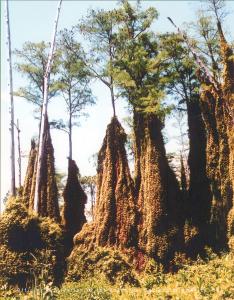
|
A severe infestation of <IT>Lygodium microphyllum</IT> (Cav.) R. Br. located at Jonathan Dickinson State Park, Martin County, Florida, USA. A native of the Old World tropics, <IT>L. microphyllum</IT> has become a serious pest in the forested wetlands of South Florida since naturalizing in the 1960s. Within severe infestations, this vine-like fern can smother both the understory and canopy, disrupting the recruitment of native vegetation and altering local fire ecology. The spread of this species appears to be facilitated by its ability to reproduce via intragametophytic selfing.
|
copyright: BSA,
license: http://images.botany.org/index.html#license |
Image
|
Reproductive Biology

|

|
|
abot90-9
|
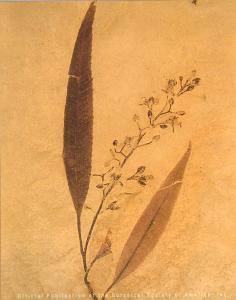
|
Rare fossil twig with attached leaves and flowers of Pseudosalix handleyi, a newly recognized genus and species of the Salicaceae from the Eocene Green River Formation of northeastern Utah. Although similar to Salix in leaf architecture, unisexual flowers, and capsular fruits, this plant differs by its branched inflorescences and well-developed perianth. The fossil is interpreted to belong within the family Salicaceae s.l., as the immediate sister group to the clade containing extant Salix and Populus.
|
copyright: BSA,
license: http://images.botany.org/index.html#license |
Image
|
Unclassified

|

|
|
abot91-1
|
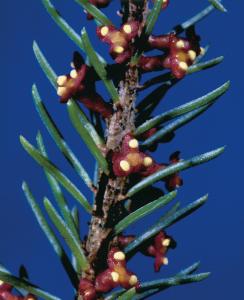
|
Staminate inflorescences of Arceuthobium pusillum (eastern dwarf mistletoe, Viscaceae) emerging from the branch of its black spruce host (Picea mariana, host needles ca. 1.0 cm long). Among all the mistletoes, Arceuthobium has the greatest economic impact on human activity because of the damage these parasites inflict on commercially important forest trees. Whereas traditional classification of these plants has proven difficult owing to extreme reduction and lost of morphological features, molecular characters have yielded a well-resolved phylogeny.
|
copyright: -
license: http://images.botany.org/index.html#license |
Image
|
Systematics

|

|
|
abot91-10
|
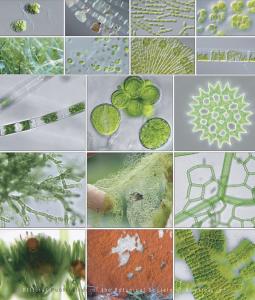
|
These photographs of green algae represent the group's diversity of cellular architecture and growth habit.
|
copyright: Lewis & McCourt, BSA
license: http://images.botany.org/index.html#license |
Image
|
Anatomy and Morphology

|

|
|
abot91-11
|
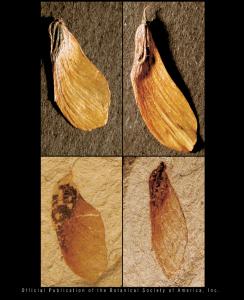
|
Winged fruits of modern and fossil Loxopterygium. Two modern species (top row) from seasonally dry tropical forests in South America are distinguished in fruit by the length of the pedicel. A new fossil species of Loxopterygium fruit from Miocene inter-Andean basins of Ecuador is morphologically similar to both modern species.
|
copyright: Burnham, BSA
license: http://images.botany.org/index.html#license |
Image
|
Unclassified

|

|
|
abot91-12
|
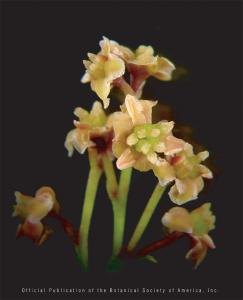
|
Female flowers of Amborella trichopoda. A study of Amborella, a candidate for the basal-most angiosperm, and B-function MADS-box genes.
|
copyright: Kim, BSA
license: http://images.botany.org/index.html#license |
Image
|
Systematics

|

|
|
abot91-2
|
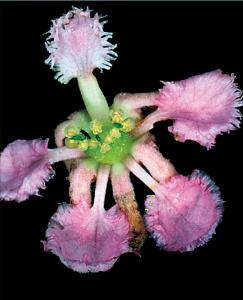
|
Jubelina rosea (Malpighiaceae) from French Guiana. Malpighiaceae have been difficult to place phylogenetically owing in part to their highly specialized floral morphology, a likely adaptation to their association with oil-bee pollinators.
|
copyright: -
license: http://images.botany.org/index.html#license |
Image
|
Systematics

|

|
|
abot91-3
|
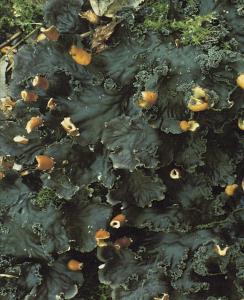
|
Lichen-forming fungus Peltigera praetextata (Sommerf.) Zopf growing on mosses in northern Poland. The thallus of this common bipartite lichen contains the cyanobacterium Nostoc, which is frequently present, sometimes in addition to a green algal photobiont, in tripartite peltigeralean lichens. Small squamules (phyllidia) on the thallus surface are asexual propagules containing both symbionts (fungus and Nostoc). Pale brown, saddle-shaped fruit bodies (apothecia) contain sexual propagules (ascospores) of the mycobiont. A new classification for peltigeralean lichens is established here based on a comprehensive molecular phylogenetic study.
|
copyright: BSA
license: http://images.botany.org/index.html#license |
Image
|
Systematics

|

|
|
abot91-4
|
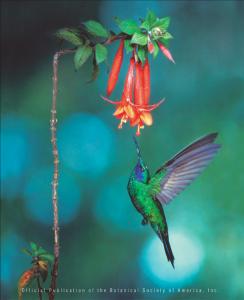
|
A Sparkling Violetear Hummingbird (Colibri coruscans) visiting flowers of Fuchsia ampliata near Yanacocha, on the slopes of Volcan Pichincha close to Quito, Ecuador. Nearly all of the New World species of Fuchsia are pollinated by hummingbirds, whereas the South Pacific species are pollinated mainly by honeyeaters (Meliphagidae).
|
copyright: -
license: http://images.botany.org/index.html#license |
Image
|
Systematics

|

|
|
abot91-5
|
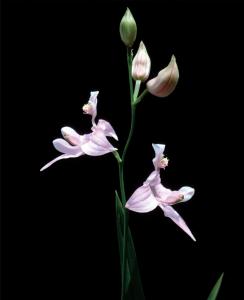
|
Inflorescence of Calopogon oklahomensis (Orchidaceae), a recently described species from the midwestern and southeastern United States. Calopogon, a small genus of primarily wetland plants native to eastern North America and the northern Caribbean, has had uncertain infrageneric taxonomy and relationships.
|
copyright: BSA
license: http://images.botany.org/index.html#license |
Image
|
Systematics

|

|
|
abot91-6
|
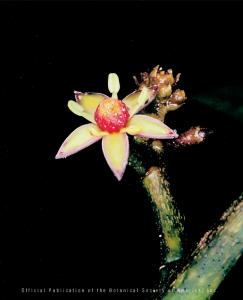
|
Tetraplasandra gymnocarpa (Hillebr.) Sherff is the only species in the Araliaceae with a fully superior ovary. This endangered species is endemic to the windswept, summit cliffs of the Koolau Mountain Range of Oahu, Hawaiian Islands. The superior ovary in T. gymnocarpa developed from an inferior ovary ground plan. It is hypothesized that this evolutionary shift could be due to a shift in pollinator strategy that allowed a relaxation of the selective pressures favoring an inferior ovary.
|
copyright: BSA
license: http://images.botany.org/index.html#license |
Image
|
Structure and Development

|

|
|
abot91-7
|
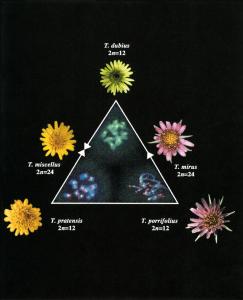
|
Over 50 years ago, Ownbey published the discovery of the newly formed allotetraploids of Tragopogon. Color photographs of these plants and their diploid parents and hybrids formed an historical color plate in the American Journal of Botany. Tragopogon continues to serve as a model for recent allopolyploidy, as shown on this cover and characterized by Pires et al. using molecular cytogenetics in this issue. The triangle indicates parentage and reciprocal origins of tetraploid species of Tragopogon from their diploid progenitors in North America. Arrows indicate diploid(s) contributing plastids to the tetraploids. Fluorescent in situ hybridization of centromeric (green) and subtelomeric (red) repetitive elements are shown on metaphase chromosomes of the diploid species.
|
copyright: -
license: http://images.botany.org/index.html#license |
Image
|
Genetics and Molecular Biology

|

|
|
abot91-8
|

|
Summit stairway, Whiteface Mountain, New York. Moss species richness increased significantly as species dispersed from lowland sources following the introduction of mortar during construction.
|
copyright: Miller, BSA
license: http://images.botany.org/index.html#license |
Image
|
Bryology and Lichenology

|

|
|
abot91-9
|
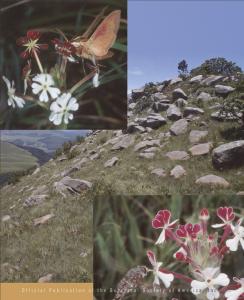
|
A hawk moth (Basiothia schenki, Sphingidae) visiting the night-flowering Zaluzianskya natalensis (Scrophulariaceae; upper left) and a long-proboscid fly (Prosoeca ganglbauri, Nemestrinidae) visiting the day-flowering Z. microsiphon (lower right). These two plant species occur sympatrically on Mt. Gilboa, South Africa. Morphological and inter-simple sequence repeat (ISSR) data support the hypothesis that gene flow is occurring between these species despite their apparent ethological isolation.
|
copyright: Johnson, Mort, BSA
license: http://images.botany.org/index.html#license |
Image
|
Population Biology

|

|
|
abot92-1
|
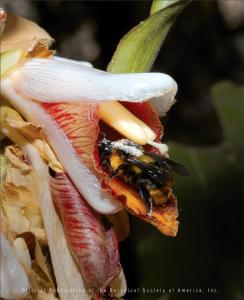
|
Alpinia, the largest genus in the ginger family (Zingiberaceae), is primarily pollinated by bees. At the Cai Yung Hu Reserve in Yunnan, China, the single anther of each flower of A. blepharocalyx deposits pollen on the back of the Bombus pollinators as they enter the flowers to take nectar. Alpinia as currently defined includes six polyphyletic clades in the tribe Alpinieae.
|
copyright: Kress, BSA
license: http://images.botany.org/index.html#license |
Image
|
Systematics

|

|
|
abot92-10
|
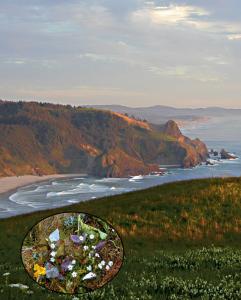
|
A coastal prairie and UNESCO Biosphere Reserve north of Lincoln City, Oregon,
USA on the Pacific Ocean. The ungrazed promontory of the preserve supports a
diverse flora and fauna, including rare and endemic species. Color-coded organza
bags were used to retrieve inbred and outbred progeny from hand pollinations
of the rare Silene douglasii var. oraria (inset) for reintroduction.
Transplants of outbred progeny had higher survival over 5 years than the inbred
progeny in this headland (foreground), and seedling establishment was lowest
for the rare variety in natural and experimental plots. This case study will
facilitate the design of larger scale attempts at successful reintroductions.
|
copyright: Susan R. Kephart, BSA
license: http://images.botany.org/index.html#license |
Image
|
Population Biology

|

|
|
abot92-11
|
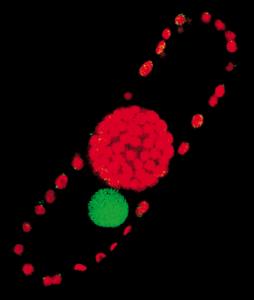
|
Confocal optical section of a living chlorenchyma cell (stained with the nucleic
acid stain acridine orange) of Bienertia cycloptera, which possesses
a novel mechanism for C4 photosynthesis. Enzymes and organelles are
partitioned into two separate compartments within a single chlorenchyma cell.
The nucleus (green) is juxtaposed between a large, central cytoplasmic compartment,
densely packed with chloroplasts (red autofluorescence), and a peripheral compartment
with uniformly distributed chloroplasts. The cover is dedicated to co-author,
Vincent Raymond Franceschi (1953-2005), who contributed to the discovery of
single-cell C4 photosynthesis.
|
copyright: Simon D. X. Chuong, BSA
license: http://images.botany.org/index.html#license |
Image
|
Cell Biology

|

|
|
abot92-12
|
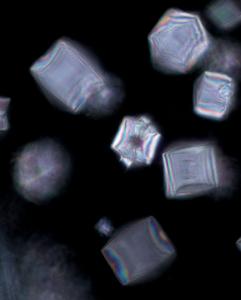
|
About 75% of flowering plants produce calcium oxalate crystals in some or all
of their organs. Because these crystals occur in various shapes and hydration
states that are specific and consistent within each organ, they have been used
periodically as an internal taxonomic character. Since crystals and their macropatterns
are usually retained in the mature leaves and stems even after they die or drop
off the plant, such information should be useful for identification purposes,
possibly in forensics. Only a few studies have followed the development of the
crystals into what is called a macropattern in a mature organ such as a leaf.
Such a study can aid our understanding of how different crystals form and how
they relate to their specific organ tissues. Shown here are large, prismatic
crystals in cleared mesophyll cells of a pomegranate leaf, observed between
crossed polarizers. The prismatic crystal nearest the center of the image has
a central, nonpolarizing core, and two of the crystals display epitactic or
surface crystals.
|
copyright: Harry T. Horner, BSA
license: http://images.botany.org/index.html#license |
Image
|
Anatomy and Morphology

|

|
|
abot92-2
|
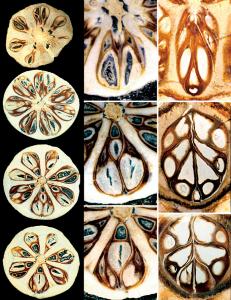
|
Anatomically preserved fossils of Shirleya
grahamae (Lythraceae), from the middle Miocene Yakima Canyon flora
of central Washington State, USA. In the left column are transverse sections
of the fruit from near the apex to the base showing tightly packed seeds;
the central column shows details of the seeds with a triangular embryo
cavity and large inflated distal wing; the right column shows tangential
sections from inside to outside.
|
copyright: Kathleen B. Pigg, BSA
license: http://images.botany.org/index.html#license |
Image
|
Unclassified

|

|